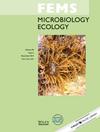Phylogenetic diversity of Rhizobium species recovered from nodules of common beans (Phaseolus vulgaris L.) in fields in Uganda: R. phaseoli, R. etli, and R. hidalgonense
IF 3.5
3区 生物学
Q2 MICROBIOLOGY
引用次数: 0
Abstract
A total of 75 bacterial isolates were obtained from nodules of beans cultivated across 10 sites in six agro-ecological zones in Uganda. Using recA gene sequence analysis, 66 isolates were identified as members of the genus Rhizobium, while nine were related to Agrobacterium species. In the recA gene tree, most Rhizobium strains were classified into five recognized species. Phylogenetic analysis based on six concatenated sequences (recA-rpoB-dnaK-glnII-gyrB-atpD) placed 32 representative strains into five distinct Rhizobium species, consistent with the species groups observed in the recA gene tree: R. phaseoli, R. etli, R. hidalgonense, R. ecuadorense, and R. sophoriradicis, with the first three being the predominant. The rhizobial strains grouped into three nodC subclades within the symbiovar phaseoli clade, encompassing strains from distinct phylogenetic groups. This pattern reflects the conservation of symbiotic genes, likely acquired through horizontal gene transfer among diverse rhizobial species. The 32 representative strains formed symbiotic relationships with host beans, while the Agrobacterium strains did not form nodules and lacked symbiotic genes. Multivariate analysis revealed that species distribution was influenced by the environmental factors of the sampling sites, emphasizing the need to consider these factors in future effectiveness studies to identify effective nitrogen-fixing strains for specific locations.从乌干达田间普通豆(Phaseolus vulgaris L.)结核中发现的根瘤菌物种的系统发育多样性:R.phaseoli、R.etli 和 R. hidalgonense
从乌干达 6 个农业生态区 10 个地点种植的豆类结核中获得了 75 个细菌分离物。通过 recA 基因序列分析,66 个分离物被鉴定为根瘤菌属,9 个与农杆菌属有关。在 recA 基因树中,大多数根瘤菌菌株被分为五个公认的种。基于 6 个连接序列(recA-rpoB-dnaK-glnII-gyrB-atpD)的系统发生分析将 32 个代表性菌株归入 5 个不同的根瘤菌种,与在 recA 基因树中观察到的菌种群一致:R.phaseoli、R.etli、R.hidalgonense、R.ecuadorense 和 R.sophoriradicis,其中前三个是主要的。根瘤菌菌株在共生相叶菌支系中分为三个 nodC 亚支系,包括来自不同系统发育群的菌株。这种模式反映了共生基因的保存,很可能是通过不同根瘤菌之间的水平基因转移获得的。32 个代表性菌株与寄主豆类形成了共生关系,而农杆菌菌株没有形成结核,也缺乏共生基因。多变量分析表明,物种分布受采样地点环境因素的影响,强调在未来的有效性研究中需要考虑这些因素,以确定特定地点的有效固氮菌株。
本文章由计算机程序翻译,如有差异,请以英文原文为准。
求助全文
约1分钟内获得全文
求助全文
来源期刊

FEMS microbiology ecology
生物-微生物学
CiteScore
7.50
自引率
2.40%
发文量
132
审稿时长
3 months
期刊介绍:
FEMS Microbiology Ecology aims to ensure efficient publication of high-quality papers that are original and provide a significant contribution to the understanding of microbial ecology. The journal contains Research Articles and MiniReviews on fundamental aspects of the ecology of microorganisms in natural soil, aquatic and atmospheric habitats, including extreme environments, and in artificial or managed environments. Research papers on pure cultures and in the areas of plant pathology and medical, food or veterinary microbiology will be published where they provide valuable generic information on microbial ecology. Papers can deal with culturable and non-culturable forms of any type of microorganism: bacteria, archaea, filamentous fungi, yeasts, protozoa, cyanobacteria, algae or viruses. In addition, the journal will publish Perspectives, Current Opinion and Controversy Articles, Commentaries and Letters to the Editor on topical issues in microbial ecology.
- Application of ecological theory to microbial ecology
- Interactions and signalling between microorganisms and with plants and animals
- Interactions between microorganisms and their physicochemical enviornment
- Microbial aspects of biogeochemical cycles and processes
- Microbial community ecology
- Phylogenetic and functional diversity of microbial communities
- Evolutionary biology of microorganisms
 求助内容:
求助内容: 应助结果提醒方式:
应助结果提醒方式:


